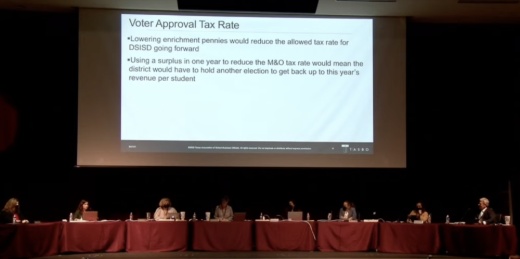The average homeowner will see increases in their tax bills due to rapidly rising property values, which was a concern discussed at the meeting.
The new tax rate consists of a maintenance and operations rate of $0.9603 and an interest and sinking fund rate of $0.3500. The M&O rate represents a slight decrease from $0.9832.
That decrease stems from a Texas Legislative change, HB3 which passed in 2019, aimed to help homeowners facing growing taxes. The bill requires schools to reduce their M&O rates as property values increase to offset some of the cost passed to homeowners.
“Our property values have skyrocketed so much and our tax rate decrease has not caught up to that,” Trustee Stefani Reinold said.
Trustees debated the tax rate for about two hours. Reinold argued that the trustees should lower the rate to help homeowners, many who have reached out to the district to express concern over rising tax bills.
However, other trustees felt the rate was needed to maintain the district as it tries to keep up with Hays County’s growing population.
District considerations
Reinold said that the slight decrease in the tax rate, stemming from the M&O compression, and its overall low number might not appear alarming to taxpayers, but the overall increase to the bill will.
“That’s alarming to me,” Reinold said. “This is happening and our taxes are increasing and this is on the board. What are we going to do about it?”
She pointed to an increase in students, up more than 9% this year according to the board, and an increase in money coming into the district. She expressed concern the district needed to ease the taxpayers’ burden if possible.
Trustee Shannon O'Connor said the increasing revenue is going toward paying for the additional students and the new school campuses opened in the past several years. Trustee Joanna Day added that the revenue per student is not increasing each year.
Reinold also expressed concern over the district’s fund balance—the amount of money it keeps in reserve. The district’s fund sits at about $39 million, according to the board.
Trustee Ron Jones stated that that amount is roughly equal to six months of the district’s expenses. The state requires districts to keep enough money in the bank to cover four months of operating expenses, meaning the district could only potentially spend down their savings by two months, or about one-third, of costs.
Reinold said she is concerned that taxpayer’s bills are going up, and the district is asking for more money through bonds—the last in 2018 with another planned for the future.
“I’m seeing a pattern that is very concerning as a taxpayer, as a constituent in this community and I’m understanding some frustration in this community,” Reinold said.
Day pointed 86% of the operating budget goes toward staff, meaning any possible reduction in cost would have to come from that cost bucket, something she does not feel is possible.
“I think everyone on the board is seeing their property values go up and their property taxes go up,” Day said. “Our job is to educate students and to do the best we can with the funds we have available to us.”
Reinold agreed that the district faces many challenges—a need for staff, infrastructure issues, teachers not being able to afford living in the district—but she said she feels reducing the tax burden would help to address these.
Ultimately, the tax rate passed 6-to-1 with Reinold dissenting.
“If you are going to cut, and you can’t cut people, you are going to have to cut programs, and I don’t think that is what our community expects,” said trustee Mary Jane Hetrick.
In a tough spot
Amanda Brownson, a representative with Texas Association of School Business Officials, which advises school districts on financial matters, shared with the board a few of the major factors behind the suggested tax rate.
The first is that if the district were to reduce its golden pennies, a portion of the tax it collects that is not subject to state recapture, it would not only lose that money, but it would lose state funding, via the formula transition grant. That grant is state funds approved by the Texas Legislature to ensure school districts receive at least a 3% increase for student funding each year.
Brownson said that if schools lower their “tax effort,” in other words lowering the taxes they collect from the community, past a certain point the state can take away their aid.
The district has the option to reduce its golden pennies, but then it could end up subject to more recapture cost—the mechanism through which the state takes funds from property tax wealth districts and redistribute it, according to Brownson.
The second issue is the voter approval tax ratification election cap. This is the amount a school district is allowed to increase their tax rate before they have to get voter approval. Currently, Dripping Springs ISD is at the top of the rate. If they lower it this year, they would not be able to increase it to its current rate again without getting voter approval.
Brownson said this means that trying to pass the savings of a good fiscal year on to taxpayers could present future funding issues for the district.
“You could create a financial hole not just next year, but on into the future,” Brownson said.





